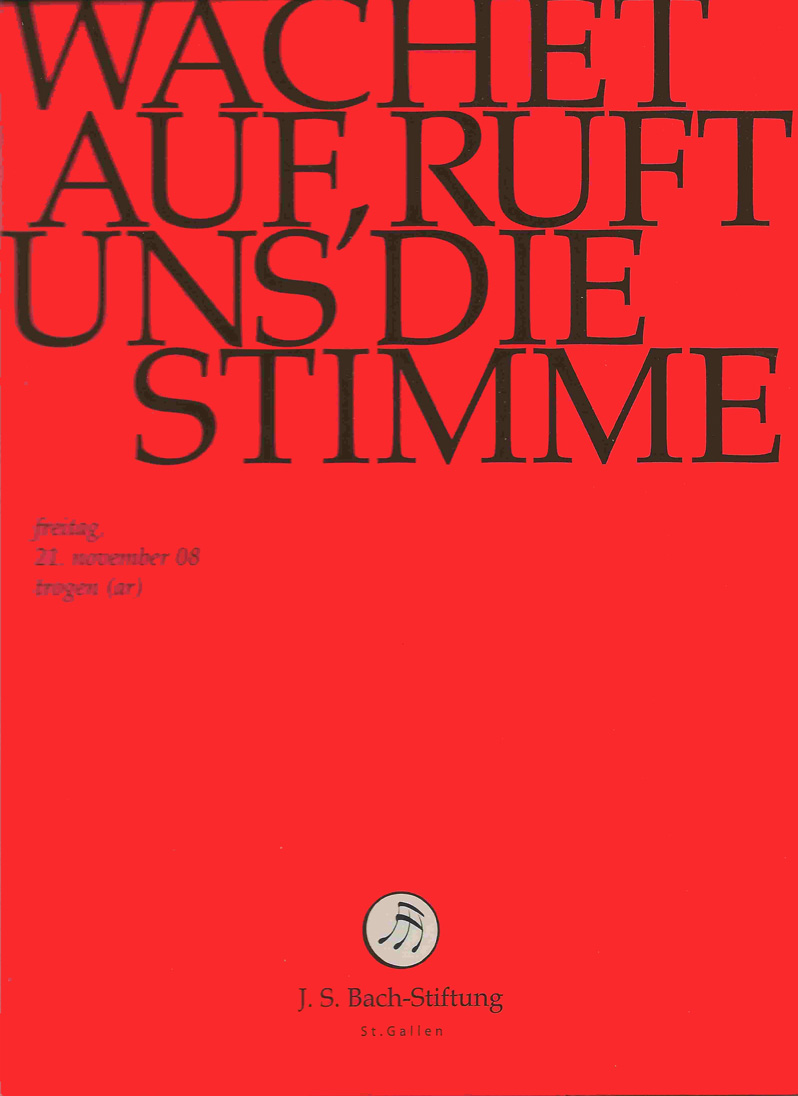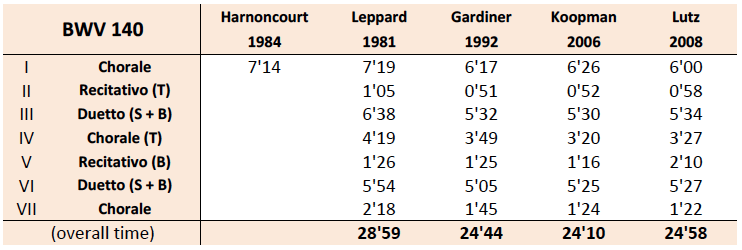Johann Sebastian Bach
Cantata BWV 140, “Wachet auf, ruft uns die Stimme“
Media Review / Comparison
2012-08-08 — Original posting (on Blogger)
2013-03-18 — Added recording with Raymond Leppard, timing table
2014-11-03 — Re-posting as is (WordPress)
2016-06-28 — Brushed up for better readability
Table of Contents
Introduction — The Recordings
I have recently come across the YouTube recording of the aria “Auch mit gedämpften schwachen Stimmen” from the cantata “Schwingt freudig euch empor”, BWV 36. This was performed the J.S.Bach Foundation St.Gallen under Rudolf Lutz, with Nuria Rial, soprano, and John Holloway, violin. I was so fascinated by Nuria Rial’s way of singing that aria (so natural, lively and unpretentious) that I decided to “have a closer look” at the three cantata recordings in that series (so far) featuring this singer. One of these is the Cantata “Wachet auf, ruft uns die Stimme”, BWV 140 (for the 27th Sunday after Trinitatis on November 25th, 1731). I currently have four complete recordings of this cantata, and one fragment:
- Leppard, English Chamber Orchestra, London Voices (1981)
- Harnoncourt, Concentus musicus (1984, partial)
- Gardiner, Monteverdi Choir, English Baroque Soloists (1992)
- Koopman, Amsterdam Baroque Orchestra & Choir (2006)
- Lutz, J.S.Bach-Stiftung St.Gallen (2008, DVD)
Nikolaus Harnoncourt (1984)
Johann Sebastian Bach: The Sacred Cantatas — Famous Choruses
Gustav Leonhardt, Leonhardt Consort
Nikolaus Harnoncourt, Concentus Musicus Wien
Teldec 4509-92626-2 (CDs, stereo); ℗ 1971 – 1989 / © 1993

This is a CD that I received as a gift – a collection of choruses from the venerable complete recording of all Bach cantatas directed by Gustav Leonhardt and Nikolaus Harnoncourt (some of which I have on LPs still). Out of the collection on this CD, only the entry piece (the Corale “Wachet auf, ruft ins die Stimme”, recorded around 1984) is from the cantata discussed here, performed by the Concentus Musicus Wien and the Tölzer Knabenchor. This collection of choral cantata highlights only includes one movement from BWV 140:
The Performance
1. Corale “Wachet auf, ruft uns die Stimme”
Harnoncourt’s recording is getting old(ish) — it clearly originates from the early / pioneering days of historically informed playing. Harnoncourt (or that entire series from the early 80’s) relied on boys’ choirs for the choral parts. There may be good arguments for this (after all, Bach’s main occupation was as teacher at the Thomanerschule in Leipzig) — however, even the best boys’ choirs can hardly reach the degree of differentiation, detailed phrasing and articulation that some of the small vocal ensembles in the other recordings can offer: compared to the other interpretations, this choir sounds static, sometimes clumsy, linear, not very differentiated. On the bright(er) side: the sound of the orchestra is very warm, nice and detailed.
7:14 — rating: ***
Overall Rating
3.0 / 5 (1 track)
Raymond Leppard (1981)
Johann Sebastian Bach: St.John Passion BWV 245; Cantata BWV 140
Eugen Jochum, Royal Concertgebouw Orchestra, Ernst Haefliger, Walter Berry, Agnes Giebel, Marga Höffgen, Alexander Young, Franz Crass, Netherlands Radio Chorus (BWV 245)
Raymond Leppard, English Chamber Orchestra, Elly Ameling, Aldo Baldin, Samuel Ramey, London Voices (BWV 140)
Philips 462 173-2 (2 CDs, stereo); ℗ / © 1998

This cantata performance under the direction of Raymond Leppard (1927 – 2019) is added as a “filler” with Eugen Jochum’s recording of Bach’s St.John Passion BWV 245; the recording of the cantata was made in 1981 — and the articulation (the playing general) reflects the style of that time — in parts hard to listen to nowadays, musicians would likely not dare playing this way any longer!
The Performance
1. Corale “Wachet auf, ruft uns die Stimme”
Orchestra sound dominated by modern oboes and a substantial string body, very traditional, broad articulation in the choir, the tempo at the lower limit; at least, the orchestra does not play all legato — it’s just fairly massive (but less static than Harnoncourt!).
7:19 — rating: ***
2. Recitativo (tenor) “Er kommt, er kommt”
Beautiful tenor voice — but vastly overdone for a recitativo.
1:05 — rating: ***
3. Aria (duetto, soprano & bass) “Wenn kömmst du, mein Heil?”
The violino piccolo uses extreme vibrato, not clean, same for the singers, the tempo is very allow — does not move (probably to accommodate the violino piccolo)
6:38 — rating: **
4. Corale (tenor) “Zion hört die Wächter singen”
Sung by the choir, with slow, heavy tempo and extreme, “operatic” vibrato, sounding like a choir in a opera by Verdi; the articulation in the strings is extremely broad, “thick”, overblown.
4’19 — Rating: **
5. Recitativo (bass) “So geh herein zu mir”
Somewhat heavy vibrato, but otherwise mostly OK.
1:26 — rating: ***
6. Aria (duetto, soprano & bass) “Mein Freund ist mein”
Not that bad at all — if only the soprano wasn’t using such a heavy, overblown vibrato!
5:54 — rating: **
7. Corale “Gloria sei dir gesungen”
Extremely broad — broader than if a church community was singing along — and with strong choir and string vibrato. Sounds as if recorded in the 60’s or early 70’s.
2:18 — rating: **
Overall Rating
2.4 / 5 (7 tracks)
John Eliot Gardiner (1992)
Johann Sebastian Bach: Cantatas BWV 140, 147
John Eliot Gardiner, The Monteverdi Choir, The English Baroque Soloists
DG Archiv Produktion 431 809-2 (CD, stereo); ℗ 1992

This is an early cantata recording by John Eliot Gardiner, released in 1992. This is with thea) English Baroque Soloists, the Monteverdi Choir, Ruth Holton (soprano), Anthony Rolfe Johnson (tenor) and Stephen Varcoe (bass). The violino piccolo is played by Alison Bury.
Choir: 6+4+4+4 (18), strings: 4+4+2+2+1 (13)
The Performance
1. Corale “Wachet auf, ruft uns die Stimme”
Clean, but static, and a bit neutral
6:17 — rating: ****
2. Recitativo (tenor) “Er kommt, er kommt”
0:51 — rating: ****
3. Aria (duetto, soprano & bass) “Wenn kömmst du, mein Heil?”
The violino piccolo (hard to play!) is not very clean
5:32 — rating: ***
4. Corale (tenor) “Zion hört die Wächter singen”
Gardiner has this sung by the choir; his tempo is relatively slow
3:49 — Rating: ***
5. Recitativo (bass) “So geh herein zu mir”
To me, this recitatvo is a bit too much “celebrated”
1:25 — rating: ***
6. Aria (duetto, soprano & bass) “Mein Freund ist mein”
For this duetto, I prefer a more mature female voice (given the underlying text). Otherwise, the sound is clear, maybe somewhat sharp
5:05 — rating: **
7. Corale “Gloria sei dir gesungen”
I don’t like Gardiner’s very static phrasing, concluding every phrase with the same fermata
1:45 — rating: **
Overall Rating
3.0 / 5 (7 tracks)
Ton Koopman (2006)
Johann Sebastian Bach: Complete Cantatas, Vol.21
(Cantatas BWV 34, 97, 100, 118, 140, 143, 158, 177, 191, 195, 197, 200)
Ton Koopman, The Amsterdam Baroque Orchestra & Choir
Antoine Marchand / Challenge Classics CC72221 (3 CDs, stereo); ℗ / © 2006

Volume 21 of Ton Koopman‘s cantata recording includes BWV 140, recorded in 2006, with the Amsterdam Baroque Orchestra & Choir, Sandrine Piau (soprano), James Gilchrist (tenor), and Klaus Mertens (bass). The violino piccolo is played by Margaret Faultless.
Choir: 6+4+5+4 (19), strings: 5+4+2+2+1 (14)
The Performance
1. Corale “Wachet auf, ruft uns die Stimme”
A good, clean studio recording; both the orchestra and the choir are and sound bigger, more homogeneous & polished than the one below
6:26 — rating: *****
2. Recitativo (tenor) “Er kommt, er kommt”
0:52 — rating: ****
3. Aria (duetto, soprano & bass) “Wenn kömmst du, mein Heil?”
Good soprano, and Klaus Mertens certainly is an excellent & very experienced bass, with excellent voice control — very good overall! The aspect worth mentioning here is that Margaret Faultless pays tribute to her name on the violino piccolo — to a degree that one starts doubting whether she really plays a violino piccolo! One could argue that Bach deliberately selected this hard-to-play instrument four its particular sound effect, and the fact that this is hard to hear in this recording could be regarded as minor deficiency…
5:30 — rating: *****
4. Corale (tenor) “Zion hört die Wächter singen”
Also Koopman has this sung by the choir — but his tempo is more fluent, the orchestra exhibits a lot of detail, excellent phrasing and articulation.
3:20 — rating: ****
5. Recitativo (bass) “So geh herein zu mir”
1:16 — rating: ****
6. Aria (duetto, soprano & bass) “Mein Freund ist mein”
The soloists are clearly better than Gardiner’s: the tempo is slightly slower here, but definitely OK.
5:25 — rating: ****
7. Corale “Gloria sei dir gesungen”
Koopman’s phrasing is relatively static here — this gives away some directness, makes the movement less “speaking”.
1:24 — rating: ****
Overall Rating
4.3 / 5 (7 tracks)
J.S. Bach Foundation, St.Gallen (2007)
Johann Sebastian Bach: Cantata “Wachet auf, ruft uns die Stimme”, BWV 140
Rudolf Lutz, J.S.Bach-Stiftung St.Gallen (recorded live)
J.S.Bach-Stiftung DVD A495 (DVD, stereo 2.0); © 2008

In 2007, the J.S. Bach Foundation in St.Gallen, Switzerland launched their project of recording Bach’s entire cantata work over the course of 25 years, 1 cantata per month. The performances (one cantata at a time) are accompanied by a preceding, public workshop (in German) by the conductor, Rudolf Lutz, and a theologist, Karl Graf; the cantatas are performed twice the same evening, with a reflection (in German) in-between (the concerts are held in the nice, baroque church of Trogen, AR, Switzerland). The workshops, the cantata and the reflection are recorded live, on DVD. The main artists are Rudolf Lutz, the orchestra “schola seconda pratica“, and the “vokalensemble der schola seconda pratica“. In this particular cantata, these artists are assisted by Nuria Rial, Bernhard Berchtold (tenor), and Markus Volpert (bass). The violino piccolo is played by Chiara Banchini.
Choir: 4+4+3+3 (14), strings: 3+3+2+1+1 (10)
The Performance
1. Corale “Wachet auf, ruft uns die Stimme”
Clearly, this is the recording with the most drive and life (it’s the fastest in this selection, too), the most vivid, most agile of these performances (having the smallest ensemble of course helps!): it may be less “polished” than Koopman’s — but the al fresco effect of a live performance more than outbalances this difference: I like this — just watch for yourself!
6:00 — rating: ***** (& more!)
2. Recitativo (tenor) “Er kommt, er kommt”
Bernhard Berchtold (in my opinion) has the best, most brilliant voice among the solo tenors in this comparison — even though ideally, one might wish for more of a lyrical tenor for Bach’s cantatas in general: Berchtold maybe is on the brink of being (too much of) a Heldentenor.
0:58 — rating: *****
3. Aria (duetto, soprano & bass) “Wenn kömmst du, mein Heil?”
Koopman may have the best bass soloist — but definitely, Nuria Rial is the best soprano in this comparison (see above): her singing is so natural, free / unconstrained, not artificial at all — hard to beat! (Maybe one could argue that a little less vibrato would be even better — but that is a minor point.) The bass is less experienced, has slightly less voice control than Klaus Mertens (in the recording with Ton Koopman), and hence doesn’t quite match Nuria Rial’s qualities.
5:34 — rating: ****
4. Corale (tenor) “Zion hört die Wächter singen”
In this recording, this corale is sung by the (excellent) solo tenor. At first, this may sound unusual (intuitively, most people might expect a choir to sing this; I haven’t seen the sources, but Bach may have labeled this with “tenore” only) — to me, this absolutely makes sense, not only because it is a single vocal voice only, but also because with a solo voice the (text) message is conveyed far more clearly, directly and personally — I like the idea!
3:27 — rating: *****
5. Recitativo (bass) “So geh herein zu mir”
The vibrato is maybe a bit on the strong side here,
2:10 — rating: ****
6. Aria (duetto, soprano & bass) “Mein Freund ist mein”
Once more, the soprano (Nuria Rial) is excellent, the al fresco of the live recording beats any perfection of competing studio recordings!
5:27 — rating: *****
7. Corale “Gloria sei dir gesungen”
The most flexible, most “speaking” among the recordings in this comparison. The chamber organ was maybe a bit too close to the microphones here (imperfect balance is one of the dangers in live recordings!) — to me, it is too dominating in this movement, although in the other movements the organ and the continuo in general are simply excellent.
1:22 — rating: *****
Overall Rating
4.7 / 5 (7 tracks)
Conclusions
Ton Koopman / Amsterdam Baroque
Koopman’s recordings are pretty good, overall; judging from this and other recordings in his cantata series (I have listened to all of them — 1488 tracks, 3 days of music!), his recordings may often not be the best, but there are rarely (if any) bad or mediocre tracks, let alone serious failures among them. Sure, they are studio recordings, and sometimes, one can (to some degree) sense that (most) cantatas were not recorded in a single session, but in sessions often months apart: that’s one of the disadvantages of recording with exclusive or highly reputed soloists!
Rudolf Lutz / J.S.Bach Foundation St.Gallen
Rudolf Lutz and the J.S.Bach-Stiftung St.Gallen are at the early phase of a very long project (25 years!) — they do one cantata at a time, one cantata per month, i.e., they can devote a lot more energy to the preparation of any given cantata. They do live recordings, they use a fairly small ensemble, all young, enthusiastic, often sparkling vocalists and instrumentalists. Plus, one gets the benefit of being able to watch the performance (I tried hard not to be biased by the visual component!).
It definitely is refreshing to see this orchestra act, moving freely (all but very few artists perform standing here), to see them interact with each other, to see how baroque instruments are played (strings are playing largely without vibrato), how they look, to hear their sound. Even without the video component, this (to me) is the top recording here, and I have started pondering whether to purchase all past yearly volumes (52 cantatas so far, up to 2011). Sure, the other recordings may not feature Nuria Rial etc. — but even without specific soloists, what I have seen / listened to so far is very strong, very convincing, clearly my favorite recording here!
The main limitation (“internationally speaking”) with this series is that the workshops and the reflections are in German only, no captioning is available, and most cantatas are available as video / DVD only (so far, select cantatas are available as CD / audio recording as well), and at least when purchased individually, the DVDs are expensive compared to typical CDs or MP3 downloads — nasty people might say “for 20 – 30 minutes of a single cantata only!”. For me, however, the result is still very good value for the price!
Timings
To give an overview on the timing of the various recordings, here’s a table for all of the above:












